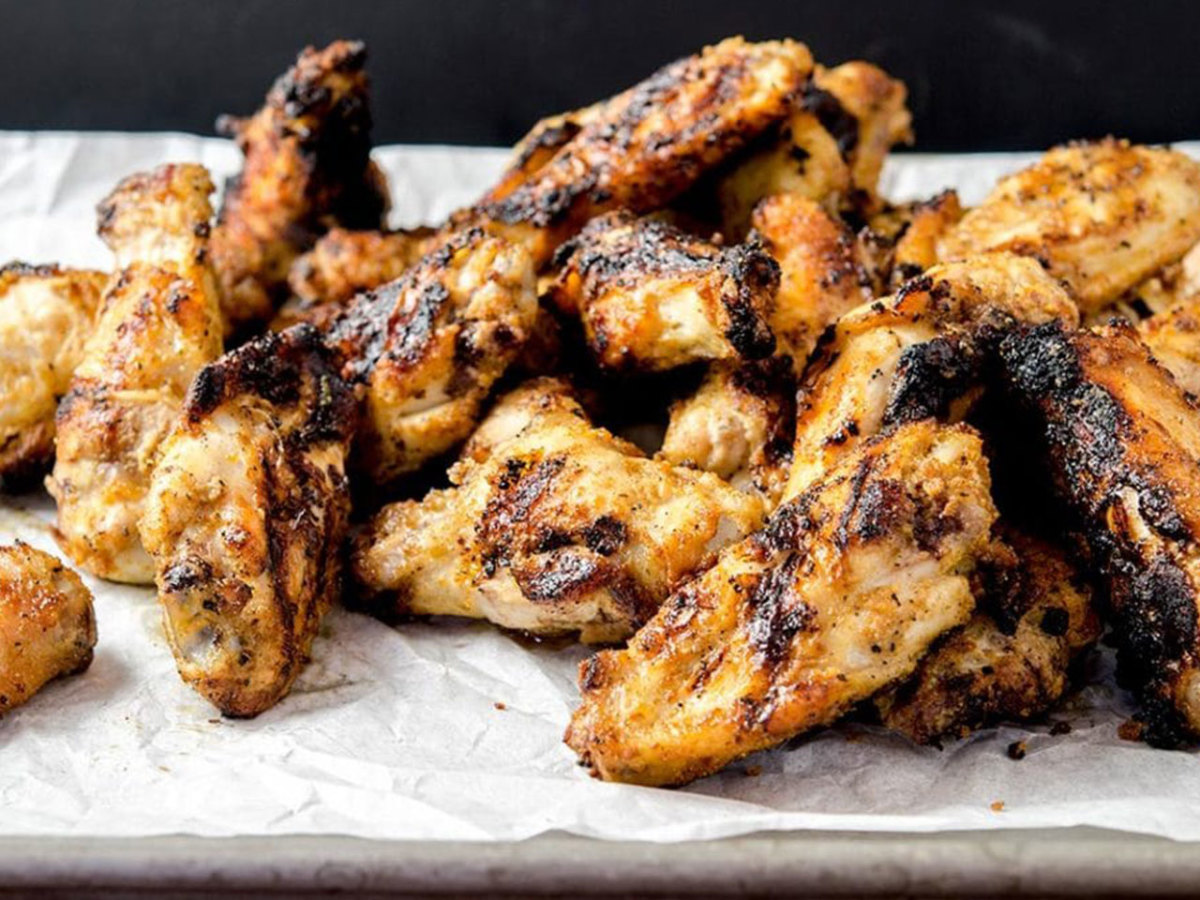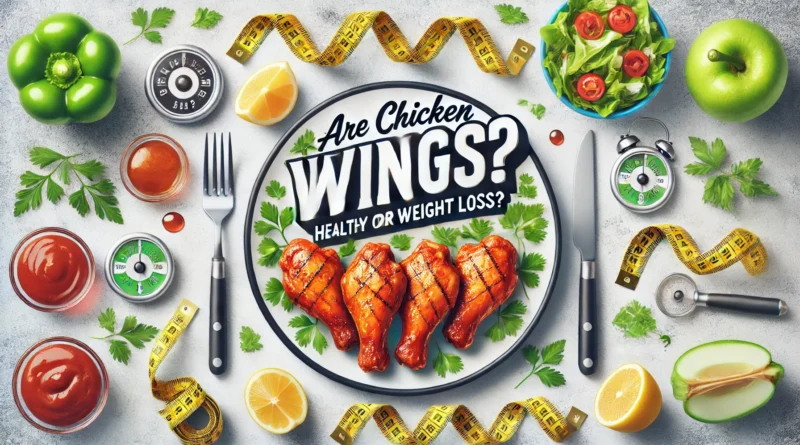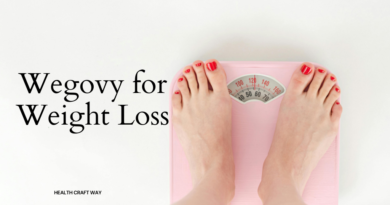Are Chicken Wings Healthy for Weight Loss: Myth or Fact?
Chicken wings can be part of a weight loss plan, but it depends on how they are prepared. Fried wings are high in calories and fat, while baked or grilled wings are healthier options.
Many people love chicken wings for their delicious taste and versatility. But if you’re trying to lose weight, you might wonder if they fit into your diet. The good news is that chicken wings can be enjoyed while losing weight, if you make smart choices.
Opt for baked or grilled wings instead of fried ones. Remove the skin to cut down on fat and calories. Pair them with fresh veggies instead of high-calorie dips. By making these changes, you can enjoy chicken wings without sabotaging your weight loss goals. In this post, we’ll explore how to make chicken wings a healthy part of your diet.
Nutritional Profile
Chicken wings are a popular snack and meal choice. But are they healthy for weight loss? To understand this, we need to look at their nutritional profile. Knowing the calories and protein content can help you make informed decisions.
Calories In Chicken Wings
Calories play a key role in weight loss. Chicken wings can be high in calories, especially when fried. Here is a breakdown:
- Plain, cooked chicken wings (without skin): Around 43 calories per wing.
- Plain, cooked chicken wings (with skin): Around 99 calories per wing.
- Fried chicken wings: Can have up to 160 calories per wing.
To better understand, here is a table showing different types of chicken wings and their calorie content:
| Type of Chicken Wing | Calories per Wing |
|---|---|
| Plain, cooked (without skin) | 43 |
| Plain, cooked (with skin) | 99 |
| Fried | 160 |
Choosing plain, skinless wings can be a lower-calorie option. Cooking methods matter too. Grilling or baking can reduce calorie intake compared to frying.
Protein Content
Protein is important for muscle growth and repair. It also helps you feel full, which can aid in weight loss. Chicken wings offer a good source of protein:
- Plain, cooked chicken wings (without skin): Around 6.4 grams of protein per wing.
- Plain, cooked chicken wings (with skin): Around 6.8 grams of protein per wing.
- Fried chicken wings: Around 6.3 grams of protein per wing.
Here’s a table showing the protein content of different types of chicken wings:
| Type of Chicken Wing | Protein per Wing (grams) |
|---|---|
| Plain, cooked (without skin) | 6.4 |
| Plain, cooked (with skin) | 6.8 |
| Fried | 6.3 |
Opting for plain, cooked wings can maximize protein intake. This can help you stay full longer. Thus, aiding in weight loss. Remember to balance your diet with other protein sources.

Preparation Methods
Chicken wings are a popular dish loved by many. But are they healthy for weight loss? The answer depends on how they are prepared. Different cooking methods can significantly impact their nutritional value and calorie content. Here, we explore the various preparation methods to determine which ones are better for weight loss.
Fried Vs. Baked
Fried chicken wings are a common favorite. But they can be a problem if you are trying to lose weight. Deep-frying adds a lot of extra calories. The oil used in frying soaks into the chicken, increasing the fat content. This is not ideal for weight loss. On the other hand, baked chicken wings are a healthier option. Baking requires less oil and still delivers great flavor. You can even skip the oil and use a light cooking spray. This reduces the calorie count significantly. Here’s a quick comparison:
| Preparation Method | Calories (per 100g) | Fat (per 100g) |
|---|---|---|
| Fried | 290 | 20g |
| Baked | 200 | 10g |
As seen in the table, baked wings have fewer calories and less fat. This makes them a better choice for weight loss. Additionally, baking allows you to season the wings with herbs and spices. This enhances the flavor without adding extra calories. Consider the following tips to make your baked wings even healthier:
- Use skinless chicken wings to cut down on fat.
- Season with garlic, paprika, and pepper for added flavor.
- Pair with a light dipping sauce like Greek yogurt-based dips.
Grilled Options
Grilling is another excellent method for preparing chicken wings. It’s a low-fat cooking method that uses direct heat. This helps to render out fat from the wings while keeping them juicy. Grilled wings are often lower in calories compared to fried wings. Grilling also adds a unique smoky flavor. This makes the wings tasty without needing much seasoning. Here are some benefits of grilled chicken wings:
- Lower in fat compared to fried wings.
- Retains more nutrients due to shorter cooking time.
- Can be cooked without added oils.
To make your grilled chicken wings even healthier, consider these tips:
- Marinate the wings in a mix of lemon juice, garlic, and herbs.
- Grill on medium heat to avoid charring, which can be unhealthy.
- Serve with a side of fresh vegetables or a light salad.
Grilled wings can be a tasty and healthy addition to your diet. They are lower in calories and fat, making them a good choice for weight loss. Plus, the grilling process enhances the natural flavors of the chicken.
Sauces And Seasonings
When considering chicken wings for weight loss, sauces and seasonings play a crucial role. The way you flavor your wings can significantly impact their nutritional value. Understanding the difference between high-calorie sauces and healthier alternatives can help you make better choices.
High-calorie Sauces
Many popular chicken wing sauces are loaded with calories, sugar, and unhealthy fats. These can quickly turn a healthy meal into a calorie-dense indulgence. Here are some common high-calorie sauces:
- Buffalo Sauce: While tangy and delicious, it often contains high levels of butter and hot sauce, adding unnecessary calories and fat.
- Barbecue Sauce: Typically high in sugar and preservatives, barbecue sauce can add a significant calorie load.
- Ranch Dressing: Frequently used as a dip, ranch dressing is high in fat and calories, making it a less ideal choice for weight loss.
Below is a table summarizing the calorie content of these sauces per serving (2 tablespoons):
| Sauce | Calories | Fat (g) | Sugar (g) |
|---|---|---|---|
| Buffalo Sauce | 90 | 8 | 0 |
| Barbecue Sauce | 70 | 0 | 16 |
| Ranch Dressing | 140 | 14 | 1 |
By being aware of these high-calorie sauces, you can better manage your calorie intake and make choices that align with your weight loss goals.
Healthier Alternatives
Switching to healthier sauces and seasonings can make chicken wings a more diet-friendly option. Here are some alternatives to consider:
- Hot Sauce: Low in calories and high in flavor, hot sauce can add a kick to your wings without the extra fat.
- Mustard: This tangy condiment is low in calories and adds a unique flavor to your wings.
- Herbs and Spices: Using fresh or dried herbs like rosemary, thyme, or paprika can add flavor without extra calories.
Here’s a table showing the calorie content of these healthier alternatives per serving (2 tablespoons):
| Sauce/Seasoning | Calories | Fat (g) | Sugar (g) |
|---|---|---|---|
| Hot Sauce | 5 | 0 | 1 |
| Mustard | 10 | 0 | 1 |
| Herbs and Spices | Varies | 0 | 0 |
Opting for these healthier alternatives can help you enjoy your chicken wings without compromising your weight loss goals. They provide flavor and satisfaction with fewer calories and healthier ingredients.

Portion Control
Chicken wings can be a delicious snack, but are they healthy for weight loss? The answer often lies in portion control. Knowing how much to eat can make a big difference in reaching your weight loss goals. Let’s explore the importance of portion control and how it impacts your diet.
Recommended Serving Size
When enjoying chicken wings, it is important to stick to a recommended serving size. Eating too many can add extra calories, which may hinder weight loss. Typically, a serving size for chicken wings is about 4.4 ounces or approximately 4-5 wings. Here are some tips to help you manage your portions:
- Measure your portions: Use a kitchen scale to weigh 4.4 ounces of wings.
- Pre-portion your meals: Divide wings into small containers before eating.
- Avoid eating from large plates: Use smaller plates to avoid overfilling.
- Chew slowly: Eating slowly can make you feel fuller faster.
It may also be useful to know the nutrition facts for a 4.4-ounce serving of chicken wings:
| Nutrient | Amount |
|---|---|
| Calories | 220 |
| Protein | 18g |
| Fat | 15g |
| Carbohydrates | 0g |
Being mindful of these numbers can help you keep your diet on track. Small steps like this can make a big difference in the long run.
Impact On Caloric Intake
Portion control directly impacts your caloric intake. Eating more than the recommended serving size can easily lead to consuming excess calories. For weight loss, it is crucial to burn more calories than you eat. Consider this: If you eat 10 chicken wings instead of the recommended 4-5, you could double your calorie intake. This means consuming around 440 calories instead of 220. Extra calories need to be burned off through physical activity, which can be challenging. Here are a few activities to burn off the extra 220 calories:
- Walking for 45 minutes at a moderate pace.
- Jogging for 25 minutes.
- Swimming for 30 minutes.
- Doing 40 minutes of high-intensity interval training (HIIT).
Keeping your portion sizes in check helps avoid these extra workouts. Plus, maintaining a balanced diet becomes easier. It is not just about eating less but eating smart. Balance your meals with vegetables and lean proteins to stay full and satisfied. Remember, mindful eating plays a key role in weight loss. Practice portion control to make chicken wings a part of your healthy diet.
Protein And Satiety
Are chicken wings healthy for weight loss? This question often comes up for those on a diet. One key aspect to consider is the protein content in chicken wings. High-protein foods can help you feel full longer and maintain muscle mass during weight loss. This concept, known as “protein and satiety,” is essential for effective weight management.
Feeling Full Longer
Protein is known for its ability to promote satiety. When you consume protein-rich foods like chicken wings, you are likely to feel full for a longer period. This helps in reducing overall calorie intake. Here are some reasons why protein helps you stay full:
- Slow Digestion: Protein takes longer to digest compared to carbs and fats. This results in a prolonged feeling of fullness.
- Hormonal Impact: Consuming protein affects hormones like ghrelin, which is responsible for hunger. Lower ghrelin levels mean reduced appetite.
- Caloric Density: Protein is less calorie-dense. This means you can eat more of it without consuming too many calories.
To illustrate, let’s look at the nutritional profile of chicken wings:
| Nutrient | Amount (per 100g) |
|---|---|
| Protein | 30g |
| Fat | 20g |
| Carbohydrates | 0g |
This profile shows that chicken wings are high in protein and low in carbs. This makes them a good option for those looking to lose weight by controlling hunger and eating fewer calories overall.
Muscle Maintenance
Maintaining muscle mass is crucial during weight loss. Muscle helps in burning calories even at rest. Including protein-rich foods like chicken wings in your diet can support muscle maintenance. Here are some benefits:
- Protein Synthesis: Protein provides the building blocks for muscle repair and growth. This is vital during weight loss to avoid muscle loss.
- Metabolic Rate: More muscle mass increases your basal metabolic rate (BMR). This means you burn more calories throughout the day.
- Strength and Energy: Adequate protein intake supports physical performance and strength. This is important for maintaining an active lifestyle while losing weight.
For those engaging in regular exercise, chicken wings can be a good post-workout meal option:
- High Protein Content: Helps in muscle recovery and reduces muscle soreness.
- Convenient: Easy to prepare and can be paired with healthy sides like vegetables.
- Versatile: Can be seasoned in various ways to keep your meals interesting.
In summary, chicken wings can be a valuable part of a weight loss diet. They help you feel full longer and aid in muscle maintenance, both of which are essential for effective and sustainable weight loss.
Comparison With Other Snacks
Are chicken wings healthy for weight loss? The answer depends on several factors, including preparation method and portion size. To understand better, let’s compare chicken wings with other popular snacks.
Healthier Snack Options
Choosing snacks wisely can make a big difference in your weight loss journey. There are many healthier alternatives to chicken wings. These options are lower in calories, fat, and often provide more nutrients. Here are some healthier snack options:
- Vegetable sticks with hummus – Carrots, cucumbers, and bell peppers are great choices. Hummus adds protein and fiber.
- Greek yogurt with fruits – A satisfying snack that offers protein and vitamins.
- Nuts and seeds – Almonds, walnuts, and chia seeds are nutritious and filling.
- Air-popped popcorn – A low-calorie snack that is high in fiber.
- Apple slices with peanut butter – Combines fiber and healthy fats.
Let’s look at a quick comparison table:
| Snack | Calories per Serving | Benefits |
|---|---|---|
| Vegetable sticks with hummus | 100-150 | Low in calories, high in fiber and protein |
| Greek yogurt with fruits | 150-200 | High in protein, vitamins, and probiotics |
| Nuts and seeds | 200-250 | Rich in healthy fats and protein |
| Air-popped popcorn | 30-50 | Low-calorie, high in fiber |
| Apple slices with peanut butter | 150-200 | Combines fiber and healthy fats |
Caloric Comparison
Understanding the caloric content of snacks can help manage weight more effectively. Chicken wings, especially when fried, can be high in calories. Here is a comparison of calories between chicken wings and other snacks:
| Snack | Calories per Serving |
|---|---|
| Fried chicken wings (5 pieces) | 430 |
| Grilled chicken wings (5 pieces) | 280 |
| Vegetable sticks with hummus | 100-150 |
| Greek yogurt with fruits | 150-200 |
| Air-popped popcorn | 30-50 |
Fried chicken wings can have about 430 calories for five pieces. If grilled, the same amount would be around 280 calories. Compare this with vegetable sticks with hummus, which have about 100-150 calories. Air-popped popcorn is even lower, with about 30-50 calories. Choosing snacks with lower calories can help manage daily caloric intake. This is crucial for weight loss. Opting for snacks like vegetable sticks or air-popped popcorn can make a significant difference.
Dietary Considerations
Are chicken wings healthy for weight loss? It’s a question many dieters ask. Chicken wings can be part of a healthy diet, but it’s essential to consider how they fit into your dietary plan. Here, we explore some important dietary considerations for chicken wings.
Low-carb Diets
Low-carb diets focus on reducing carbohydrate intake. Chicken wings can be a suitable option for these diets. They are naturally low in carbs, especially if you avoid breading and sugary sauces. Here are some points to consider:
- Unbreaded wings: Keep them simple. Avoid adding extra carbs with breading.
- Sauces: Opt for low-carb sauces. Avoid sweetened BBQ or honey mustard sauces.
- Cooking methods: Grilling or baking is healthier. Frying can add unnecessary fats and calories.
Here’s a quick comparison of different wing preparations and their carb content:
| Preparation Method | Carbs (per 100g) |
|---|---|
| Grilled, unbreaded | 0g |
| Baked, unbreaded | 0g |
| Fried, breaded | 15g |
| With BBQ sauce | 20g |
By choosing the right preparation and sauces, chicken wings can fit well into a low-carb diet. They provide protein and fat, which can help you stay full longer.
High-protein Diets
High-protein diets emphasize protein intake to support muscle growth and satiety. Chicken wings are an excellent source of protein, making them a good choice for such diets. Consider these points:
- Protein content: Chicken wings are rich in protein. One serving (100g) can provide around 20g of protein.
- Satiety: High-protein foods help you feel full. This can prevent overeating and support weight loss.
- Nutrient balance: Pair wings with vegetables. This ensures a balanced meal with vitamins and minerals.
Here’s a breakdown of the protein content in different wing preparations:
| Preparation Method | Protein (per 100g) |
|---|---|
| Grilled, unbreaded | 23g |
| Baked, unbreaded | 22g |
| Fried, breaded | 18g |
Chicken wings can be a valuable part of a high-protein diet. Choose healthier cooking methods and pair with nutrient-dense sides for a balanced meal.
Incorporating Chicken Wings
Chicken wings are a popular food choice for many. But are they healthy for weight loss? The answer can be yes, if you incorporate them wisely into your diet. By making smart choices, chicken wings can be a part of your weight loss plan. The key is to prepare and pair them with healthy options.
Balanced Meal Ideas
Creating balanced meals with chicken wings can help you stay on track with your weight loss goals. Here are some ideas:
- Grilled Chicken Wings with Veggies: Grilling reduces the need for added fats. Pair with steamed broccoli or a mixed vegetable salad.
- Baked Wings with Quinoa: Baking wings instead of frying cuts down on calories. Serve with a side of quinoa and a cucumber-tomato salad.
- Buffalo Wings with Sweet Potato Fries: Use a light buffalo sauce and bake the wings. Serve with homemade sweet potato fries baked with minimal oil.
Here is a quick comparison table to show the difference between fried and baked wings:
| Type | Calories | Fat |
|---|---|---|
| Fried Wings (3 pieces) | 387 | 27g |
| Baked Wings (3 pieces) | 270 | 18g |
As you can see, baking reduces the calorie and fat content significantly. This makes baked wings a better option for weight loss.
Meal Prep Tips
Planning and preparing your meals in advance can help you stick to your diet. Here are some tips:
- Batch Cooking: Cook a large batch of chicken wings at once. You can grill or bake them. Store in the refrigerator for up to 4 days.
- Portion Control: Divide the wings into single-serving portions. This helps avoid overeating. Use containers to keep the portions separate.
- Mix and Match: Prepare different sides like salads, roasted veggies, and whole grains. Mix and match these with your chicken wings for variety.
- Use Marinades: Marinate your wings with healthy options like lemon juice, olive oil, garlic, and herbs. Avoid sugary sauces and high-sodium options.
Here is a simple meal prep plan for the week:
| Day | Meal | Side |
|---|---|---|
| Monday | Grilled Wings | Quinoa Salad |
| Tuesday | Baked Wings | Steamed Veggies |
| Wednesday | Buffalo Wings | Sweet Potato Fries |
| Thursday | Grilled Wings | Mixed Salad |
| Friday | Baked Wings | Roasted Veggies |
Following these tips and meal ideas can make it easier to include chicken wings in a healthy, weight-loss-friendly diet.

Frequently Asked Questions
Are Chicken Wings Healthy For Weight Loss?
Chicken wings can be part of a weight loss diet if baked or grilled. Avoid frying and heavy sauces. Keep portions moderate.
How Many Calories Are In Chicken Wings?
A single chicken wing typically contains around 43-99 calories, depending on preparation. Opt for baked or grilled for fewer calories.
Can I Eat Chicken Wings On A Diet?
Yes, you can eat chicken wings on a diet. Choose healthier cooking methods like baking or grilling. Avoid high-calorie sauces.
What Is The Best Way To Cook Chicken Wings For Weight Loss?
The best way to cook chicken wings for weight loss is by baking or grilling. These methods reduce added fats and calories.
Conclusion
Chicken wings can be part of a healthy diet. Choose grilled or baked options. Avoid fried wings to cut down on calories. Pair them with veggies for added nutrition. Watch your portion sizes to avoid overeating. Balance is key for weight loss.
Enjoy chicken wings in moderation. Stay mindful of your overall diet. Healthier choices lead to better results. Keep your goals in sight and stay consistent. Eating well helps you reach your weight loss goals.




